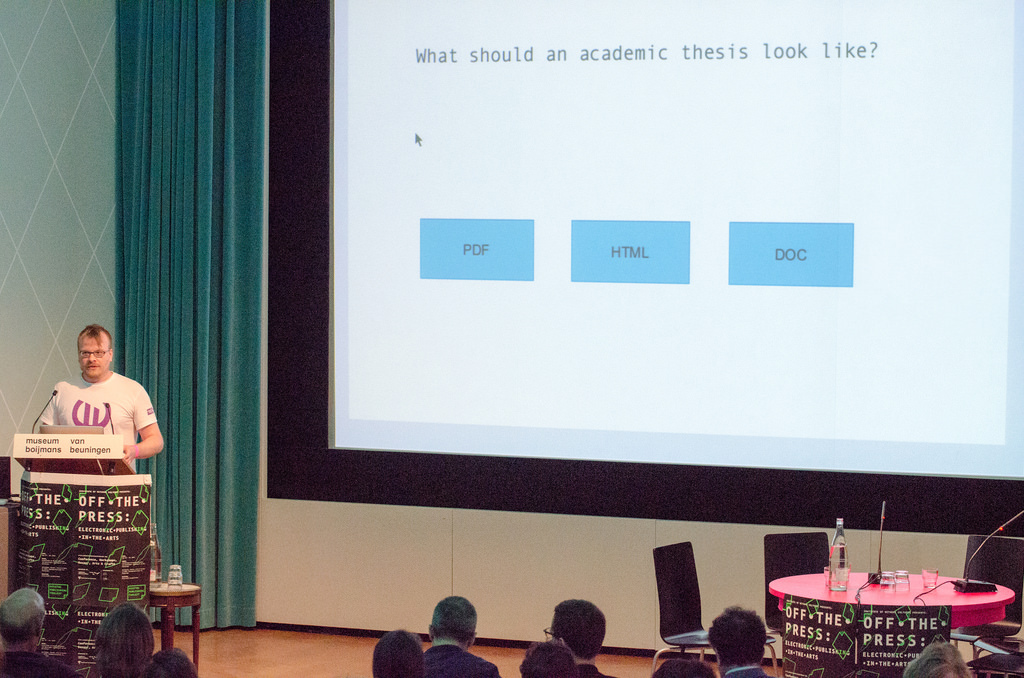A post by Mathijs Weijers
John Haltiwanger was the third speaker of session 2, which focused on publishing workflows, tools and platforms.
His talk aimed to give the audience a better understanding of the recent work of Gilbert Simondon on cybernetics theory. Simonodon’s work shines a new perspective on Norbert Wiener’
s theory of cybernetics, originally published in 1948, but it is often hard to grasp by readers. Hence, Haltiwanger wanted to offer the audience a clear analysis of the essential terms of Simondon’s vocabulary on cybernetics.
Haltiwanger warned that he is not an academic, and that he became interested in the topic when doing his master’s thesis in New Media and Digital Culture at University of Amsterdam: “I had to make a decision about the format the thesis should be published in: PDF, HTML or .doc?”. Choosing the right format seems to be very easy but actually can be problematic, as each has its own specificity. PDF might have a clean interface but it’s hard to archive and be read by machines – HTML would do that job better. Word Documents are, in his opinion, standard formats that are required in the academic environment but have little benefits and reduced usability. There is furthermore the issue of proprietary formats. While he used the open-source Libre software to write his thesis, when exporting to PDF it crashed. These inconsistencies are harmful as “knowledge is too important to be locked in proprietary tools”. Thus, the thesis topic soon revolved around the very format that academic publications can take, Haltiwanger joked. Yet, this is why he believes that understanding the vocabulary for discussing the cybernetics theory of Simondon is important, as users are forced to simplify or even weaken the content of what they are working on in order to get a desired format. Whilst there are so many format options, Haltiwanger argued, “we are constrained by liberty”.

Haltiwanger explained Simondon’s cybernetics theory by a couple of terms. The first one is medium specificity. Its official definition is: “1. the fact, condition, or quality of being specific. 2 the quality of being specific to a particular organism”. In the context of publishing, a book and a Kindle have different specificities: the Kindle is built with cheap labour and needs a charger, the book needs trees as primary material and a shelf to be placed on. Knowing this, how should an academic paper look like? PDF, HTML or Word?
The next term is metastability. To explain this definition, Haltiwanger used a picture of an iceberg. An iceberg affects its environment but the environment also shapes the iceberg – it’s a dynamic progress. This metastability is taking place in the digital age as well. There are components that influence each other, hence digital objects will be different tomorrow.
The third term is transduction, defined by Simodon as follows:
“An operation–physical, biological, mental, social–by which an activity propagates itself from one element to the next, within a given domain, and founds this propagation on a structuration of the domain that is realized from place to place: each area of the constituted structure serves as the principle and the model for the next area, as a primer for its constitution, to the extent that the modification expands progresively at the same time as the structuring operation. (Simondon 2009: 11).”
The term is hard to work with, and Haltiwanger proposes a replacement: calcification . This is easier explained as “what has come before you an what you choose to put back into it is going to define the next layer of bone that the world is growing”). In other words, e-publishing is constantly reshaped by the tools and practices we choose to employ now.
Finally, there is a matter of reciprocity: helping the computer with the right input so that it delivers the desire output. HTML is, according to Haltiwanger, the best suited format for the future of e-publishing.
Haltiwanger believes that tools in general evolve reciprocally with their use, as do the users of those tools. What we can do and what we wish we could do are enabled (or limited) not only by the tools we have access to but also by the larger socio-economic conditions that determine these tools and their modes of production and operation. Tools actively participate in shaping our identity as producers, makers, and appreciators. Through the case study of a multi-output typesetting workflow that uses only Libre software, his talk explored a vocabulary to think differently about how we work with text today, one of that focuses on qualities of re-composition and the dynamics of a different type of ownership.
The essential questions here, as Haltiwanger proposed in the end, are not only what tools and what experience to build but also what is the underlying skeleton of our endeavors.
You can find a PDF of his original presentation here: Presentation John Haltiwanger


